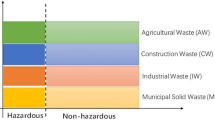Abstract
Mercury used in products and industrial processes eventually enters the environment via the waste stream. Since the management of mercury waste should prioritize reducing the amount of mercury used in products and industrial processes, this paper first describes the trends in the demand for mercury. Recent mercury demand in Japan is small in comparison to the past and other countries, and is estimated to be 8 tons per year. To manage mercury and its waste stream, it is important to understand the material flow of mercury and the types and quantities of mercury waste. About 80 tons of mercury enter Japan annually, 52 tons are recovered, and 11–24 tons are disposed of in landfill sites. Since environmentally sound treatment and disposal of mercury waste are essential, we discuss the recycling of some mercury-add products and the current state of mercury waste and mercury disposal in Japan. The remaining issue that must be addressed in the management of mercury and mercury waste is its long-term storage or disposal.






Similar content being viewed by others
References
Fitzgerald W, Engstrom D, Mason R, Nater E (1998) The case for atmospheric mercury contamination in remote areas. Environ Sci Technol 32:1–7
UNEP Chemicals (2006) Summary of supply, trade and demand information on mercury. UNEP
Ministry of the Environment, Japan, Lessons from Minamata Disease and Mercury Management in Japan, 2011
UNEP (2008) Report on current supply and demand for mercury, including projections considering the phase out of primary mercury mining
Ministry of the Environment (2013) Japan, Material flow of mercury in Japan in 2010, http://www.env.go.jp/press/file_view.php?serial=21803&hou_id=16475. Accessed at 30 March 2013 (in Japanese)
Japan Lighting Manufacturers Association (2013) Annual Statistics of Lamp Production/Sales [2008–2012], http://www.jlma.or.jp/tokei/pdf/lamp_statistics01.pdf. Accessed at 20 Sep 2013
Basel Convention (2011) Technical guidelines for the environmentally sound management of waste consisting of elemental mercury and wastes containing of contaminated with mercury
Japan Waste Management Association, recovery results of mercury from used dry cell batteries and fluorescent lamps under the Programme, http://www.jwma-tokyo.or.jp/asp/activity/kandenti/suigin.pdf (in Japanese). Accessed at 20 Sep 2013
Murase J, Matsubara S (2013) Recycling of industrial waste containing Mercury by the sole refinery plant in Japan. J Environ Saf 4(2):107–109
Japan Electric Lamp Manufacturers Association, Response to Minamata Convention on Mercury, http://www.jlma.or.jp/information/20130125UNEP_Suigin.pdf. Accessed at 20 Sep 2013 (in Japanese)
Panasonic, Akari Anshin Service, http://www2.panasonic.biz/es/lighting/akarianshin/index.html. Accessed at 20 Nov 2013 (in Japanese)
Tamura N, Miura H (2007) Treatment of mercury contained-wastes at Itomuka Plant of Nomurakohsan Co., Ltd. J MMIJ 123:747–750 (in Japanese)
Fuhrmann M, Melamed D, Kalb PD, Adams JW, Milian LW (2002) Sulfur polymer solidification/stabilization of elemental mercury waste. Waste Manag 22:327–333
Boyle JM, Lawrence BJ, Schreffler SA (2010) Method and apparatus for generating mercury (II) sulfide from elemental mercury. U.S. Patent 7,691,361
Bethlehem Apparatus, http://www.bethlehemapparatus.com/mercury-retirement.html. Accessed at 10 Jan 2011
DELA gmbh, Mercury stabilization–stabilization of mercury for final disposal by formation of mercury sulfide- http://www.mercurynetwork.org.uk/wp-content/uploads/2009/11/Orthiel.pdf. Accessed at 10 Jan 2011
López FA, López-Delgado A, Padilla I, Tayibi H, Alguacil FJ (2010) Formation of metacinnabar by milling of liquid mercury and elemental sulfur for long term mercury storage. Sci Total Environ 408:4341–4345
Fukuda N, Takaoka M, Oshita K, Mizuno T (2014) Stabilizing conditions of metal mercury in mercury sulfurization using a planetary ball mill. J Hazard Mater 276:433–441
Takaoka M, Kida A, Oguchi M, Mizutani S, Takahashi F, Asari M, Miura H (2011) Study on long-term storage and safe management of mercury recovered in Japan (K2262). Report on a Grand-in-Aid for Waste treatment Research from Ministry of the Environment, Japan (in Japanese)
Takaoka M, Kida A, Oguchi M, Takahashi F, Asari M, Moritomi H (2013) Appropriate management of the cyclical use of hazardous metals such as mercury (K113001). Report on Environment Research & Technology Development Fund from Ministry of the Environment, Japan (in Japanese)
Acknowledgments
This study was supported by a Grant-in-aid for Waste Treatment Research (K2006, K2147, K2262), and by the Environment Research and Technology Development Fund (K113001).
Author information
Authors and Affiliations
Corresponding author
Rights and permissions
About this article
Cite this article
Takaoka, M. Mercury and mercury-containing waste management in Japan. J Mater Cycles Waste Manag 17, 665–672 (2015). https://doi.org/10.1007/s10163-014-0325-z
Received:
Accepted:
Published:
Issue Date:
DOI: https://doi.org/10.1007/s10163-014-0325-z




